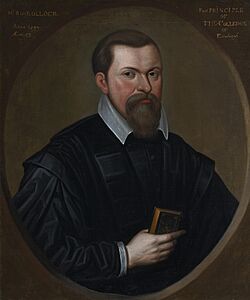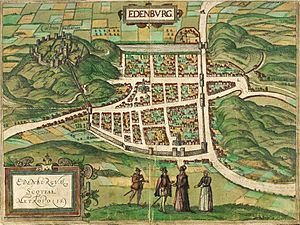Robert Rollock facts for kids
Quick facts for kids Robert Rollock |
|
|---|---|

Robert Rollock, Principal of the University of Edinburgh
|
|
| Church | Church of Scotland |
| Personal details | |
| Born | c. 1555 Powis, Scotland |
| Died | 8 or 9 February 1599 Edinburgh, Scotland |
| Alma mater | University of St Andrews, University of Edinburgh |
Robert Rollock (born around 1555, died February 8 or 9, 1599) was an important Scottish teacher and minister. He became the very first leader, or principal, of the University of Edinburgh. Robert came from a noble family and was a brilliant student.
He was chosen to help start the new college in Edinburgh in 1583. Later, in 1586, he became its first principal. As the university grew, Robert focused on teaching theology, which is the study of religion. He also worked as a minister in the Church of Scotland until he passed away in 1599. People at the time saw him as a great scholar and a very good principal.
Contents
Robert Rollock's Life Story
Early Life and School Days
Robert Rollock was born in 1555. His father was David Rollock, the laird (landowner) of Powis, near Stirling. Robert was one of at least six children. His older brother was Hercules Rollock.
He went to school in Stirling, where his teacher was Thomas Buchanan. Thomas was the nephew of a famous scholar named George Buchanan. In 1574, Robert started at St Salvator's College at the University of St Andrews. He earned his first degree in 1576 and his master's degree in 1577.
After graduating, Robert taught at St Salvator's College. He also continued his own studies in theology, Hebrew, and the study of old texts. He learned from James Melville at St Mary's College in St Andrews. Over the next few years, Robert became known across Scotland as a great teacher. People also admired how religious he was and how he inspired his students. By 1580, he was a regent at the University of St Andrews, which meant he was a main teacher and leader.
Starting the University of Edinburgh
In April 1582, King James VI gave permission for the city of Edinburgh to start its own college. This new college was first called Tounis College (Town's College). Teaching was supposed to begin in October 1583. However, the city council was still looking for a teacher in September.
James Lawson, a minister in Edinburgh, suggested Robert Rollock for the job. The city sent people to St Andrews to offer him the position. Robert agreed and became the only teacher on September 14, just one month before the first group of 80 to 90 students arrived.
His job was guaranteed for one year. If the college did well, he would get the highest position created there. Robert's salary was 40 pound Scots. The council also agreed to pay for his and one servant's daily living costs. Students from Edinburgh paid 40 Shillings, while others paid more. Robert would get extra money if the fees weren't enough.
When the university opened, Robert was the only teacher for the first-year students. As a regent, he had to teach his first group of students for all four years of their MA degree. He taught all subjects himself! Robert created the school's plan for what to teach. Another teacher, Duncan Nairn, joined him in November to help with some early lessons.
The first year focused on Latin and Greek grammar. The second year included ancient writers and arithmetic. In the third year, students learned Hebrew, ethics, logic, and physics. The fourth year added more logic, physics, geography, and theology. Robert's teaching plan was inspired by humanist ideas, which were popular at other universities. A new and exciting course on human anatomy was also part of his plan.
From May 1585 to February 1586, Robert had to close the college because of a serious outbreak of the plague. In 1586, the city council decided to make Robert the university's first principal. This meant that after his first group of students graduated in 1587, he no longer had to teach every day.
The young university grew quickly, so more teachers were hired for new students. In November 1587, the city council and local church leaders agreed that Robert could focus on teaching theology and preaching on Sundays. He was then named Professor of Theology, with a salary of 400 merks. Robert taught students who wanted to become ministers after graduating. He saw himself as both a teacher and a spiritual guide. Because of his example, the jobs of Principal and Professor of Theology stayed linked until 1620.
Later Years and Church Work
Robert Rollock started preaching at St Giles every Sunday morning in September 1587, even though he wasn't officially a minister yet. Another minister took over these duties in December 1589. Robert played a big part in the Church of Scotland and its church politics. He was often asked to join committees to deal with important church matters.
In 1590, Robert was chosen to help the leader of the general assembly of the church. In 1591, he was part of a group that talked with the king about church affairs. He also helped with issues related to certain noblemen who were causing trouble for the church. In 1595, he was asked to visit and check on Scotland's colleges. The next year, he was one of four ministers who spoke to King James VI about his "hard dealing with the kirk" (church).
Some people, like David Calderwood, said Robert was a "godly man" but sometimes too easily influenced in church matters. Robert supported the idea that some ministers should be allowed to be in parliament as bishops. He felt they should have the status and money to match their important roles. However, church historian John Row noted that Robert had previously spoken against the idea of bishops. Before he died, Robert said his main goal was for the church and state to help each other and avoid unnecessary conflict.
In 1596, Robert took on one of the eight minister roles in Edinburgh and led his own church group. Because he often agreed with the king's ideas for the church, the king's supporters helped Robert become the leader of the General Assembly held in Dundee in May 1597. In 1598, he became the minister of the Upper Tolbooth, which was part of St. Giles's Kirk. Later that year, he also became a minister at Magdalen Church, which is now known as Greyfriars Kirk.
Death and What He Left Behind
Robert Rollock had often been sick during his life, and he might have worked too hard. He passed away in Edinburgh on February 8, 1599, when he was only 44 years old.
On his deathbed, Robert said he wanted the university to remain a place for spiritual teaching. He was strongly against adding professors for law and medicine. He also asked that his former student, Henry Charteris, become his successor. The city council agreed to his wish.
David Calderwood, in his 1646 book Historie of the Kirk of Scotland, criticized Robert for being too soft on the king. However, he also said Robert was "a man of good conversation and a powerful preacher." Robert was seen as a very learned scholar who did a great job as a professor and principal in the university's early days.
Robert wrote many books on theology, mostly commentaries or explanations of the Bible. He was known internationally for his Bible commentaries. More than 40 of his works were printed in places like Edinburgh, Geneva, and Heidelberg. His writings on the Epistle to the Ephesians and the Epistle to the Romans were especially praised. A theologian from Geneva, Theodore Beza, said he had "never read in this kind of interpretation any thing exceeding them." In two books published in 1596 and 1597, Robert may have been one of the first people in Britain to write about covenant theology.
Robert married Helen Barroun around 1587. They had a daughter named Jean after Robert passed away. Jean later married Robert Balcanquhal, a minister.
The university remembers Robert Rollock with a special plaque at Old College.
Robert Rollock's Books
Robert encouraged his students to use a special way of thinking called Ramist logic to understand the Bible. He used this same method in his published books. Here are some of his main works:
- Commentary on the Letter to the Ephesians, Edinburgh, 1590.
- Commentary on the Book of Daniel the Prophet, Edinburgh, 1591.
- Analysis of the Letter to the Romans, Edinburgh, 1594.
- Questions and Answers about God's Covenant and Sacraments, Edinburgh, 1596.
- Treatise on Effective Calling, Edinburgh, 1597.
- Commentary on the Letters to the Thessalonians and Analysis of the Letter to Philemon, Edinburgh, 1598.
- Certain Sermons on several places of the Epistles of Paul, Edinburgh, 1599.
- Commentary on John's Gospel, with a Harmony from the four Gospels on the Death, Resurrection, and Ascension of God, Geneva, 1599.
- Commentary on some select Psalms, Geneva, 1598.
- Commentary on the Letters to the Corinthians, Herborn, 1600.
- Logical Analysis of the Letter to the Galatians, Edinburgh, 1602.
- Short Treatise on God's Providence, and Treatise on Excommunication, Geneva, 1602.
- A Treatise of Gods Effectual Calling, translated by H. Holland, London, 1603.
- Commentary on the Letter to the Hebrews, Edinburgh, 1605.
- Lectures upon the History of the Passion, Edinburgh, 1616.
- Episcopal Government instituted by Christ, and confirmed by Scripture and Reason, London, 1641.
Soon after he died, eleven of his sermons were published from notes taken by his students. A collection of his Selected Works was also printed in Edinburgh between 1844 and 1849.



